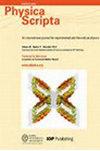天铱和天离子在球壳中的稳定性和演化
IF 2.6
3区 物理与天体物理
Q2 PHYSICS, MULTIDISCIPLINARY
引用次数: 0
摘要
由于磁性结构在数据存储、自旋电子学和其他先进技术中的潜在应用,人们对磁性结构的研究,尤其是对球壳等具有弯曲几何形状的磁性结构的研究,产生了浓厚的兴趣。然而,材料参数、几何尺寸和磁场对天球的平衡和诱导行为的影响在很大程度上仍未得到解决。在此,我们基于微磁模拟,首先研究了球壳尺寸、磁各向异性、交换相互作用和 Dzyaloshinskii-Moriya 相互作用对球壳磁态的影响。我们发现,随着厚度的增加和半径的减小,曲率效应变得更加明显,这为曲率诱导的类似 DMI 的相互作用在天融形成中的作用提供了证据。此外,我们还观察到,对球形外壳施加磁场会诱发与磁盘中类似的行为,包括天电解质与天电解质态之间的拓扑转变、天电解质的湮灭以及极性反转。我们的研究旨在推进对曲面几何中磁性现象的理解,并为新型磁性器件的开发做出贡献。本文章由计算机程序翻译,如有差异,请以英文原文为准。
Stability and evolution of skyrmionium and skyrmions in a spherical shell
The study of magnetic structures, particularly those with curved geometries such as spherical shells, has obtained significant interest due to their potential applications in data storage, spintronics, and other advanced technologies. However, the effects of material parameters, geometric dimensions, and magnetic fields on the equilibrium and induced behaviors of skyrmions remain largely unresolved. Here, based on micromagnetic simulations, we firstly investigate the influence of spherical shell dimensions, magnetic anisotropy, exchange interaction, and Dzyaloshinskii–Moriya interaction on the magnetic states of spherical shells. We find that curvature effects become more pronounced with increasing thickness and decreasing radius, providing evidence for the role of curvature-induced DMI-like interactions in skyrmion formation. Additionally, we observe that applying a magnetic field to the spherical shell induces behaviors similar to those in disks, including the topological transition between skyrmionium and skyrmion states, the annihilation of skyrmions, and polarity reversal. Our study aims to advance the understanding of magnetic phenomena in curved geometries and contribute to the development of novel magnetic devices.
求助全文
通过发布文献求助,成功后即可免费获取论文全文。
去求助
来源期刊

Physica Scripta
物理-物理:综合
CiteScore
3.70
自引率
3.40%
发文量
782
审稿时长
4.5 months
期刊介绍:
Physica Scripta is an international journal for original research in any branch of experimental and theoretical physics. Articles will be considered in any of the following topics, and interdisciplinary topics involving physics are also welcomed:
-Atomic, molecular and optical physics-
Plasma physics-
Condensed matter physics-
Mathematical physics-
Astrophysics-
High energy physics-
Nuclear physics-
Nonlinear physics.
The journal aims to increase the visibility and accessibility of research to the wider physical sciences community. Articles on topics of broad interest are encouraged and submissions in more specialist fields should endeavour to include reference to the wider context of their research in the introduction.
 求助内容:
求助内容: 应助结果提醒方式:
应助结果提醒方式:


